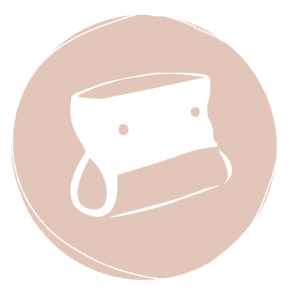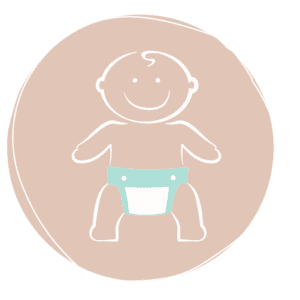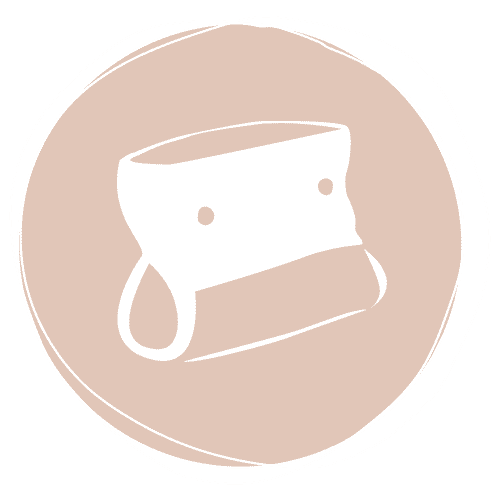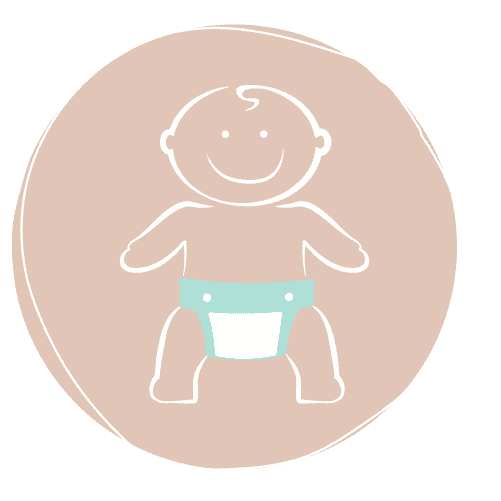FAQ cloth nappies:
HOW DO THEY WORK?




FEATURES

WASHING AND CARE

CARE AND HYGIENE
Features
of Culla di
Teby cloth nappies
We suggest you to buy 3 to 6 baby pants and 12 to 18 absorbing inserts for each size. Depending on how you will use your cloth nappies, you may need a different number of baby pants and absorbent pads.
Have a look at our kits, you will find many ready for use solutions to satisfy different needs. Or create your personal kit!
Remember that using cloth nappies even only on weekends is good for your baby’s skin and for the environment!
CULLA DI TEBY cloth nappies are 100% made in Italythey are designed, manufactured, tested and marketed in Italy.
We chose to manufacture our cloth nappies in Italy because the quality of products, work and environment is the most important thing for us. Thanks to the current strict quality standards of our country and to the choice of using certified fabrics you will be always sure of buying a product that is safe for the skin of your baby; you will be certain that Italian artisans producing our nappies are qualified and competent and they benefit of working conditions that in other countries do not even exist; and more, our cloth nappies will have to travel just a few kilometres to arrive to the changing table of your nursery, producing in this way the less Co2 as possible.
Oeko Tex is an international control system testing fabrics in order to exclude the presence of toxic substances nd to verify that the final product is safe for the wearer’s health. The textiles used to produce CULLA DI TEBY cloth nappies are in the class 1, the highest for what concern the quality standards because it has been thought for textile products destined to children up to three years of age.
Gots Certification is the quality assurance certificate for organic textile products and it includes controls on the whole production chain of fabrics, from cotton manufacturing to printing, not forgetting working conditions.
We chose to produce our baby pants in four sizes to warrant the perfect wearability of our cloth nappy, so to avoid newborns wearing nappies that are too large or older children too little ones.
The sizes follow the baby’s weight but their wearability depends on his build.
CRADLE SHAPED CLOTH NAPPIES:
- Small size baby pants, 2,5 – 5 kg; it is a cloth nappy that is perfect for newborns.
- Medium size baby pants, 5 – 11 kg; to be employed with babies that at birth already weight around 4 kg or for children between 3 and 14 months about.
- Large size baby pants, 9 – 15 kg; to be employed between 10 and 30 months about, most children will leave the diaper when wearing this size.
- XL size, + 12 kg
TEBY FITTED CLOTH NAPPY
- Fitted size 1, from 2,5 to 6 kg; it is a cloth nappy that is perfect for newborns.
- Fitted size 2, from 5 to 14 kg; it is made for babies over 5 kg. This is the size that normally most babies wear until they leave the diaper.
- Fitted size 3, from 13 kg; to be employed with older babies.
Our advice is to calculate the growth percentile of your baby and if it is above the 70th to change size 2/3 kg before the reference limit.
Here, you can easily calculate the growth percentile of your baby ( https://www.amicopediatra.it/come-fare-per/come-calcolare-i-percentili-di-crescita_sviluppo-fisico/ )
Sure! You can use your CULLA DI TEBY cloth nappies when you are not at home or on holyday. For your daily walks, it will be enough to bring with you some washable absorbent pads for the change and when they are soiled just store them in your wetbag. When back home, just put them with the other soiled absorbent pads waiting for the laundry. Or if you prefer, you can use our disposable absorbent pads, they are perfect when you are on holyday and cannot use the washing machine! …And if you go to the seaside… do not forget our Swim inserts!
Gently insert the absorbent pad in the cradle; once it is inside, pull the shorter extremities to perfectly “block” it; then, with one hand, press it on the bottom of the cradle and, with the other, pull upward the barriers around the thighs. Make a test, if the absorbent pad has been accurately placed, when lifting and shaking gently your cloth nappy, the insert should not move.
To insert a Swim absorbent pad in small size baby pants, fold one side of the insert giving it a shape that fits the size of the cradle. Our disposable absorbent pad is one-size-fits-all, so it is right it is thicker in Small size baby pants and a bit looser in Medium, Large and XL size ones.
To correctly attach the cradle to the baby pants, it will be enough that you follow the colours of the snaps. To detach it, we suggest you to be careful and gently open the snaps using your fingertips without pulling the fabric. Do not grab and pull directly the textile, it could get damaged.
All diapers, both cloth nappies and disposable ones, should be changed every 3 hours at the most. With CULLA DI TEBY cloth nappies, you can change your baby every 2 – 4 hours. You will not have to double the number of changes because normally just 1 – 2 more changes per day are enough. Breastfed newborns evacuate more often but as your baby will grow you will have to change him less often.
Many features make unique CULLA DI TEBY cloth nappies, these are just some:
- Baby pants are soft and transpiring because made of cotton.
- The four sizes allow you to really use your cloth nappies from birth until potty training (you will not need to use all sizes, in fact, some babies will not use the first or the last one)
- We made the part in PUL as small as possible.
- The parts around the thighs and around the waist are extremely soft and adaptable to your little one’s movements.
- There are neither snaps touching the baby’s skin nor elastic bands touching his waist.
- It is a hybrid nappy and this means that it can be transformed according to your needs.
- The fasteners on the back leave the belly free.
- They are easy to be worn because they do not require to be folded in a particular way.
- The cloth nappies are easy to be washed and dry quickly off because they are made of breathable textiles.
- They are manufactured using certified fabrics.
- … And above all… Made in Italy!
Washing of Teby
cloth nappies
If baby pants are not soiled, you can just detach the cradle and rinse it with a jet of water and a bit of soap. Use the same procedure for the Cover of Fitted cloth nappies. All components of Teby cloth nappies can be washed at 40°C, the absorbent parts can also be washed at 60°C. Last, please do not use cleaning products and disinfectants made with alcohol, solvents, whiteners or abrasives (like bleach, for example) and softeners because they can seriously damage Teby cloth nappies. Choose organic soaps and check on the package labels the producer instructions for the right amount you should use. In order to sanitise and whiten, you can use the percarbonate (be careful with coloured fabrics!). As a softener, it is possible to use citric acid. We suggest not to use these additives in every washing but only when there is a real need. About every 10 days, we suggest you to wash at 60° the absorbent parts with some percarbonate. If you are looking for a complete GUIDE you can read our blog article: “how to wash cloth nappies: the ten rules” https://teby.it/come-lavare-i-pannolini-lavabili-dieci-regole/
You can store the nappies that are dirty of pee and those you have pretreated in a plastic bin with a lid, but remember not to close it hermetically. We suggest you to use containers that can be easily cleaned. When the container is empty, leave it open to let circulate some air on the inside.
Teby nappies have been designed to dry quickly off. The most ecological and healthiest way to dry your cloth nappies off is surely to hang them in the open air and in the sun. However, when the weather is bad, you can put the absorbent parts and the baby pants in the dryer machine, choosing a temperature that is not too high (use the cycle for delicate or synthetic textiles). But always remember that the cradle and the cover have never to be put in the dryer machine! And what if there is not a dryer machine? Do not worry, detach the cradle and place the absorbent pads and the baby pants near a radiator but be careful they never touch it.
- Remove most of the poo by flushing it into the toilet
- With the help of a jet of water (always use cold water to pretreat!) quickly rinse and rub a vegetal soap bar directly on the absorbent pad
- Store them in the nappy bin until the moment of the laundry (we recommend to wash them every two days at the most)
- If you need to sanitise your nappies or to remove some stains, use the percarbonate with a water temperature above 50°C
No, you can lwash everything at the same timel, under the condition that you have removed most of the poo from the nappies. If you prefer, you can pre-wash only the cloth nappies before putting in the washing machine the rest of your laundry. In this way you will optimize your laundries!
Rings usually appear when pee dry out, this happens because cloth nappies are not often washed or because they have not been pretreated when there is some poo. However, if you have followed all our washing tips, you can try these whitening methods:
- Add the percarbonate in the washing machine and use a temperature above 50°C
- Leave the absorbent inserts to soak in hot water with a measuring cup of percarbonate
- Hang them in the sun! It whitens, removes stains and sanitises for free!
- Use the whitening powder made with percarbonate and TAED (an activator) that already activates at 30°C. https://teby.it/shop/it/eco-detergenti/355-sbiancante-naturale-biobianco.html
Check if you have followed all our instructions for washing and storage. Remember that the urine of every baby has a particular smell that changes depending on what he ate, hot or cold temperatures, some medicines he is taking, erupting teeth or even when a cold is coming. You will learn to understand these changes “on instinct”! But if after an accurate washing there is still a bad smell, try to use these tricks:
- Employ the right amount of soap following the producer instructions
- Sanitise your cloth nappies by washing three times the absorbent parts at 60°C with percarbonate but no soap
- Do not use Eco washing programs (modern washing machines employ too little water in these washing programs)
- If it is possible, dry them off in the sun
- If you employ a dryer machine, when the cycle is over, immediately unload your laundry and leave it in the open air for a few more hours
When using cloth nappies, every now and then some little leakages can happen, but if the cloth nappy has been correctly worn following our instructions, the baby has just been changed and the absorbent pad chosen is correct, you have to do these checks:
- Check the parts made of PUL are not damaged.
- Verify the absorbent pads absorb in the correct way by doing the pearl test. Pour a trickle of water on the absorbent pad, a small amount is enough. If water does not penetrate the textile but forms some pearls on its surface, in that case the cloth nappy has got ‘waxed’ and it has lost his absorbing power. This can happen for many reasons: employment of baby creams, softeners, too much soap or the water that is too hard. Do not worry, you can ‘reactivate’ your absorbent pads by making a stripping (3 washings at 60°C using no soap)
If you already did these operations:
- Change the nappies more often
- Increase the number of absorbent layers or mix together different fabrics
Always remember to close Velcro fasteners when you wash your cloth nappies and from time to time, using a comb, remove possible hairs from Velcro.
Cloth nappy
hygiene
In case of infections and liquid poo (due to a form of dysentery and not to the fact the baby is breastfed, in this case it is normal that poo is liquid), our advice is, just for those few days, to use our baby pants together with Culla di Teby disposable inserts and to sanitise the absorbent parts as explained below.
If you want to sanitise your cloth nappies, take all the absorbent parts and do one of these operations (but not all together!)
- Wash them at a temperature above 60°C using some percarbonate
- Absorbent pads can be washed up to 95°C
NB ALL THESE OPERATIONS HAVE TO BE DONE ONLY AND EXCLUSIVELY WITH THE ABSORBENT PADS AND NEVER WITH BABY PANTS AND CRADLES. THESE OPERATIONS CAN ACCELERATE THE UNTIMELY AGEING OF TEXTILES, we suggest not to do them frequently.
You will see that by using cloth nappies there will be far fewer nappy rashes. However, sometimes it will be necessary to use some baby creams; in this case use a nappy liner and wash thoroughly the “creamed” part with your laundry soap. The soap will remove the oily part. Then wash at 60°C.
If your baby’s sweet bottom has become red, it is better to use cloth nappies because a fabric is the best thing the skin of your little one can touch. Every skin “likes” different textiles and it is for this reason that in the same Teby absorbent insert you have a double choice: the bamboo micro sponge, that is a natural fabric, and the micro fleece, that gives a “dry effect”. Moreover, changing often the nappy will considerably lessen problems due to dermatitis. If you still have some doubts, you can have further information by reading our article “nappy rash, precautions and remedies” https://teby.it/eritema-da-pannolino-precauzioni-rimedi-della-nonna/
By using CULLA DI TEBY cloth nappies, the skin of your baby will touch a soft jersey made of cotton, the textile part of the PUL and the soft little barriers. Using the washable inserts, your baby’s skin will touch the bamboo micro-sponge and the micro-fleece, or hemp and cotton; all textiles are Oeko tex Standard 100 Class 1 certified.
For any further information regarding Culla di Teby products or requests about supplies and shipping, contact us!

